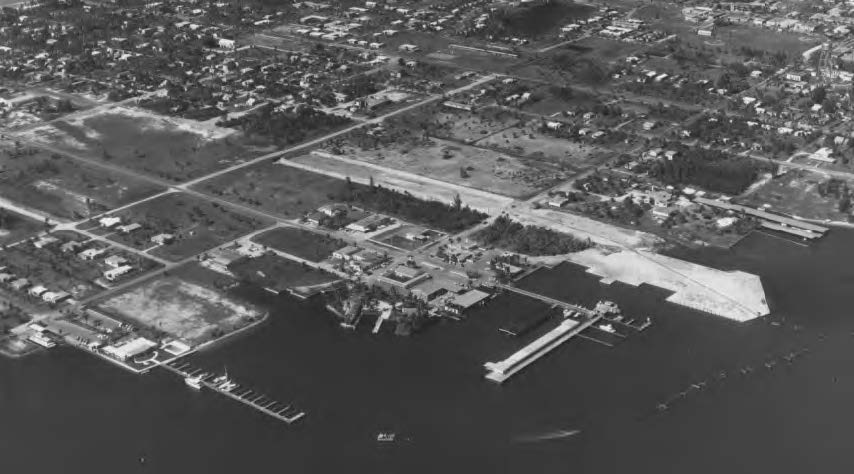History of the Cove Inn

The Tahitian Cove Congress Inn bulkhead line in 1963 is the large white area extending into Naples Bay.
by Lila Zuck, Naples Historical Society Historian
In 1961, Edward P. Schoenthaler and his wife Agnes purchased the Old Cove restaurant and lounge, the land just north of the Old Cove, the apartment units in the rear of the restaurant and the land beneath them, and the adjoining 5.25 acres of property on Naples Bay from Dr. and Mrs. Willis “Bill” Yeamans for $300,000. The parcels had been had purchased by Dr. Yeamans from B. W. Morris, Jr. in 1956.
Mr. Schoenthaler was president of the Boxcraft Corporation of Chicago, a firm which designed and manufactured packaging for cigarettes and meat products. He and his family had been regular winter visitors to Naples, before relocating permanently in 1961.
He was granted approval from City Council to construct a multi-unit yachtel and marina, the $1.5 million Tahitian Cove Congress Inn. A bulkhead line was established and filled in. It became the land on which the hotel and 75-slip marina were built. Polynesian in style, the hotel was designed by architect William Zimmerman, and constructed by the E. H. Marhoefer, Jr. Company in 1963.
Beginning in 1957, with the passage of the Bulkhead Law by the Florida Legislature, counties and cities were permitted to designate definite land limits by drawing imaginary lines known as bulkhead lines that extend out from the shore and into the water. The watery space was then filled in, thereby turning water into land. The costly creation of more real property became a practice of real estate speculators and developers, who did not receive much opposition from local governments, at first, or horrified conservationists and fishermen.
The owner and the seller of the submerged land is the State of Florida. Local governing bodies set the limits of the bulkhead lines which were then sent to the State’s Internal Improvement Board for approval. The Tahitian Cove Congress Inn was built on land filled between bulkhead lines which eliminated a once healthy, living vegetated shoreline inhabited by oysters and numerous other forms of marine life. The vegetation also filtered storm water on its final route to Naples Bay.
Two years after the 1957 Bulkhead Law was passed, municipal planners envisioned the future appearance of the state’s coastline, warning “You won’t know Florida in the 1970s. A jet pilot flying high over coastal Florida in 1970 will look carefully before he comes down, for he could easily miss his destination by a couple of cities, anywhere along the state’s 8,400 miles of shoreline, which will become a sea of housetops if shore development is not curbed and the establishment of new bulkhead lines is not kept to a minimum.”

1964 view of the completed Tahitian Cove Congress Inn
Mr. Zimmerman designed a convention hall in the main building to accommodate 300 persons, and an area in the lobby for small shops. The first occupants of the lobby spaces were Laverne- Howard Coiffures and the Waikiki Apparel & Gift Shop both of which opened in 1965. On the top level of the main building, accessed by elevators, were six “commodore suites” or penthouses, overlooking Naples Bay, with a breathtaking view of the waterway as far as Gordon Pass.
He also designed the Island Hut, a restaurant-cocktail lounge built on pilings over the water at the far eastern end of the Tahitian Cove Congress Inn. His original design of the restaurant called for a glass floor, through which the clear flowing river and fish would be visible. The construction of a heated swimming pool overlooking Naples Bay was completed by 1965.
Direct motorist access into Crayton Cove from U.S. 41 and the construction of a city park on Naples Bay came about because of the presence of the Tahitian Cove Congress Inn. In 1967, the City purchased the bay and canal frontage tracts north of the Cove Inn from private owners for $240,000, for the construction of a public park on a spoil bank and a small marina on Naples Bay. The seven-foot deep canal had been used as a base for commercial fishermen.
Before the spoil bank was created by E. Turner & Sons, who filled in the canal with rock and spoil, the canal had been the southern extension of 9th Street South. The completed project both created Naples Landing on the spoil bank and also allowed for U.S. 41 to be extended directly to the entrance of the Cove Inn. The cost to the City of the 50% federally subsidized extension of U.S. 41 was $16,000. The extension of Broad Avenue South to tie in with 9th Street South materialized in 1969.



Great story… thanks!
Would love to see more of these. As a new resident, I live learning about Naples history.
This is great. My parents started going to the Cove Innn in the 1980’s.. our family enjoys owning there. I continue to collect information.
Appreciate this.
Thank you Lila for your brilliant information about the Cove Inn! I lived there for thirty four years with my Dear husband Ed who passed last year. Although I have moved away, I get homesick & I go back to see all the lovely people that work there. Very fond memories.